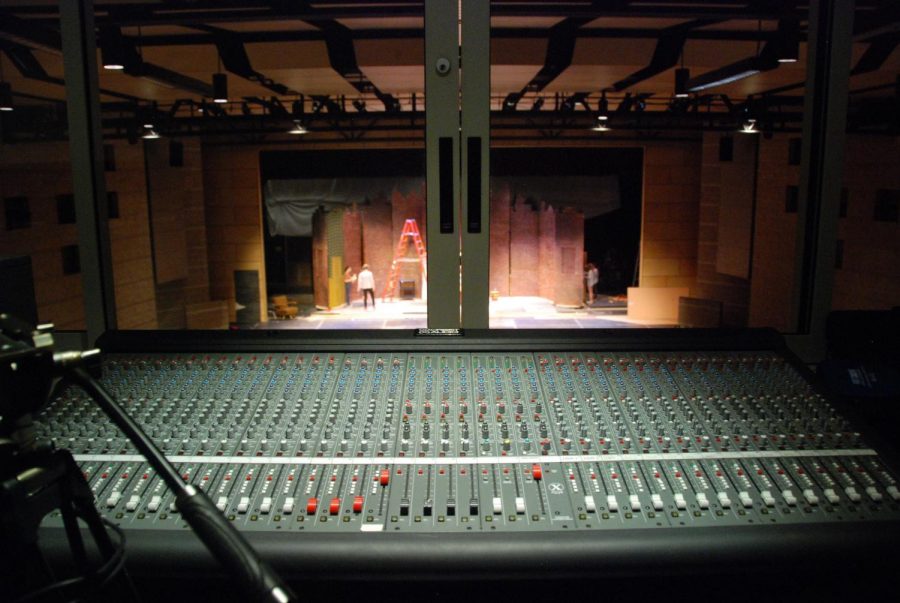The board looks exceptionally intimidating to anyone unfamiliar with production lights or projections, but the crews that use it know it well. The crews in the booth can watch the show unfold.
Turning the spotlight around: Shadowing lights
Conversely to my previous meeting, when I had to descend a flight of stairs to find the costumes crew below the stage, I had to climb up to find the lights crew. Between the two sets of doors into the Performing Arts Center lies a little-noticed door, behind which is a staircase leading up to “the booth.” When one looks up from the stage to the back of the PAC, they see a set of windows, behind which one finds the lights crew on an everyday basis.
Their first job for the day was to complete what is known as “book cueing.” This is similar to what many other crews have to do at some point during the show—it essentially entails having the crew go through the script, scene by scene, and determine how they want the lights for the show to look. They create plans for each of these moments, including at least two complete versions of ideas, and then run them by director Kristin Rust, who picks portions of each to appear in the show.
Some members of the crew stayed in the booth while others headed around the PAC and to the catwalk to view the lights. Then, each light was tested individually to make sure it was “patched”—connected—correctly and displaying the right shade of light. “Gels,” or tinted screens, were slid in front of each individual light create a warm or cool effect. During the show, different lights will be turned on at various times. There are a variety of different types, including what the crew refers to as fronts, sides, and torms—an abbreviation of “torment,” since “that’s what it is to put them up.”
The booth is packed with a myriad of mysterious equipment, oddly labeled cabinets, and knickknacks. When I questioned one (truly at random, because there were miniature dinosaurs, pink, sparkly, winged glasses, and stuffed Disney characters), I was told that nearly everything in the space is based on a story. The bedazzled hat I pointed out was a Secret Buddy gift for a projections technician years ago, and from that show on, anyone who ran the board during a show had to wear it.
“Running the board” during a show essentially means using the control board to execute all the pre-programmed commands for the lights. As Chris Sedmak explained, each time the lighting has to change onstage, someone has to hit the “go” button on the board to run the cue. The stage manager usually stays in the booth during the show to call the cues.
Previously to this point, the crew has been making lighting plots, which are computer diagrams that display how each light will be aimed and where they will be focused. They also hung all the lights, including ones from the catwalk, the walls of the PAC, and some onstage as part of the set.

This light was one of about thirty hung from the catwalk, and a gel placed in front of it makes the light it emits several shades warmer.
It is not uncommon, no matter where you are in the arts wing during a production, to hear someone yell “Blackout!” It was not until I spent some time with lights, though, that I understood why. Blacking out the PAC means all the lights go out at once, and the lights crew does this if they want to see how one specific light will look. Theater-goers in about two weeks will also notice a blackout right before the show begins and between scenes when the stage is being rearranged.
Sedmak has been on the lights crew for his entire tech career. He explained that he wanted to be on sound his first show, but his friend was lights lead that year and claimed Sedmak for the crew. He came in with no knowledge of how to work lights, and learned everything he now knows from on-the-job experience, explaining, “at least for the board, I just sat down and messed with it until I understood what I was doing.” By this show, from what I saw, he was the one in the room who every question was directed to, the one whom everyone said, “knows everything about lights.”
Sedmak also explained the process the crew goes through when they are choosing the lights for the show. I was curious about their starting place—when the script calls for a living room, for example, how do they enhance that environment? I was told that the primary driver was the simple question, “what will make [this specific situation] look realistic?” Using the living room as an example, the crew would first recognize the indoor scenario. Then, they would mimic the incandescent lights most people have in their homes.
With the onset of tech week, lights will find themselves making all final changes to the lights. They are responsible for “making sure everything is completely ready for the show,” ideally so that when the actors want to run a scene, they can do so with the show-night lights. They will also finish putting in all the gels, and finally, get to work on lighting up small elements of the set.

